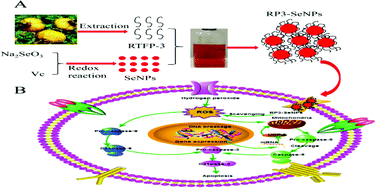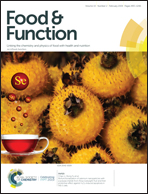Biofunctionalization of selenium nanoparticles with a polysaccharide from Rosa roxburghii fruit and their protective effect against H2O2-induced apoptosis in INS-1 cells†
Abstract
Defective glucose-stimulated insulin secretion (GSIS) induced by chronic exposure to reactive oxygen species (ROS) is a hallmark of type 2 diabetes mellitus (T2DM). Therefore, it is of great interest to search for biofunctional agents with antioxidant activity to protect pancreatic islet cells from oxidative damage. In the present study, selenium nanoparticles (SeNPs) functionalized with a novel polysaccharide (RTFP-3) extracted from Rosa roxburghii fruit were first prepared via a facile, single-step and green in situ synthesis method. The in vitro protective effects of RP3-SeNPs on INS-1 cells against H2O2-induced cell apoptosis were investigated. Structural characterization indicated that RTFP-3-functionalized SeNPs (RP3-SeNPs) with an average diameter of 104.5 nm were highly uniform and extremely stable in comparison with bare SeNPs. The results of bioassays revealed that RP3-SeNPs possessed much higher protective and suppressive activities against H2O2-induced apoptosis of INS-1 cells in comparison with their individual components. After treatment with an RP3-SeNPs solution (2 μg mL−1), the cell viability of INS-1 cells reached about 89.34%. Mechanistic studies demonstrated that RP3-SeNPs effectively blocked the overproduction of intracellular ROS, mitochondrial damage, and the activation of caspase-3, caspase-8, and caspase-9 in INS-1 cells, which indicated that RP3-SeNPs functioned via attenuating oxidative stress and downregulating the expression of uncoupling protein-2 (UCP-2). Our findings suggest that RP3-SeNPs can function as a promising candidate to prevent or limit the dysfunction of β-cells.



 Please wait while we load your content...
Please wait while we load your content...